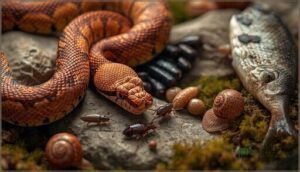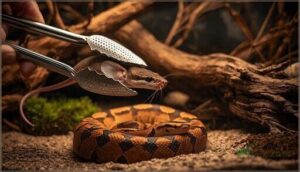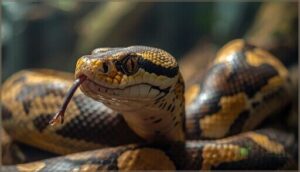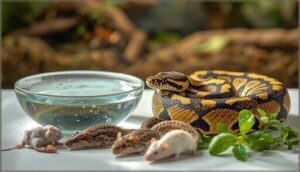This site is supported by our readers. We may earn a commission, at no cost to you, if you purchase through links.

Most new keepers struggle with this balance because snakes don’t signal hunger the way mammals do, and a feeding schedule that works perfectly for a juvenile corn snake can prove disastrous for an adult boa. Getting the timing right means understanding how age, species, and metabolism interact to determine when your snake actually needs its next meal.
Table Of Contents
- Key Takeaways
- How Often Should You Feed a Snake?
- Factors Affecting Snake Feeding Frequency
- Choosing The Right Food for Your Snake
- Safe and Effective Snake Feeding Techniques
- Recognizing Hunger and Fullness in Snakes
- Avoiding Overfeeding and Health Risks
- Maintaining Proper Hydration and Nutrition
- Frequently Asked Questions (FAQs)
- How often should snakes be fed?
- How often can one eat sweet potatoes?
- How often should you feed a king snake?
- How much should a snake eat a week?
- How often should a baby snake eat?
- How often should you feed a corn snake?
- Can snakes eat during their shedding process?
- Do snakes eat differently during brumation?
- How do stress levels affect snake appetite?
- What should I do if my snake overeats?
- Conclusion
Key Takeaways
- Your snake’s feeding frequency shifts dramatically with age—hatchlings need meals every 5-7 days to fuel rapid growth, juveniles transition to 7-10 day intervals, and adults thrive on 14-21 day schedules as their metabolism slows.
- Feeding the right prey size matters as much as timing—aim for prey that’s 10-15% of your snake’s body weight and matches its mid-body girth to prevent regurgitation, digestive stress, and the metabolic disorders that come with chronic overfeeding.
- Frozen-thawed prey offers the same nutritional value as live options while cutting injury-related vet visits by 70%, making it the safer choice for both you and your snake when paired with proper thawing and feeding tools like tongs.
- Your snake’s behavior reveals its nutritional state—watch for increased activity and tongue-flicking when it’s hungry, visible midbody swelling and retreat after eating when it’s full, and warning signs like scale spread (overfeeding) or spine protrusion (underfeeding) that demand immediate schedule adjustments.
How Often Should You Feed a Snake?
Feeding frequency varies dramatically based on your snake’s age, with hatchlings requiring meals every 5-7 days while adults may only eat every few weeks. The species you’re caring for also plays a major role—a ball python’s schedule looks quite different from a corn snake’s or boa constrictor’s.
Let’s break down exactly how often you should feed your snake at each life stage and what to expect for different species.
Feeding Frequency for Hatchlings, Juveniles, and Adults
Your snake’s feeding frequency depends primarily on its age and growth rate. Hatchlings require feeding every 5–7 days to support rapid development, while juveniles generally eat every 7–10 days as their growth slows. Adult snakes need meals only every 14–21 days, reflecting their reduced metabolic demands.
Monitoring your snake’s weight monthly helps you adjust feeding intervals based on body condition and size changes. A study showed that increased feeding frequency can greatly impact growth rates.
Feeding Frequency for Senior and Breeding Snakes
Senior adults over 18 years old usually need feeding every 10–14 days, as metabolic rate changes naturally slow their nutritional demands. Post-feeding behavior in these snakes shows reduced activity for 5–7 days, confirming these intervals support healthy digestion.
During breeding season, however, females often require meals every 7–12 days to support reproductive effort costs and clutch development. Males may need weekly feeding to maintain best breeding condition.
Studying snakes can help understand reptile senescence evolution.
Species-Specific Feeding Schedules
Beyond age, your snake species strongly influences feeding frequency based on species-specific metabolism and diet.
Ball Python adults need meals every 1–2 weeks, while juveniles eat every 5–7 days. Corn Snake adults usually feed every 7–10 days, and Boa Constrictor adults extend to 2–4 weeks. King Snake adults fall between at 10–14 days.
Tailoring schedules to your snake’s natural biology ensures best health.
Factors Affecting Snake Feeding Frequency
Feeding your snake isn’t just about following a rigid schedule—it’s about understanding what makes each animal unique. Several key factors influence how often your snake needs to eat, from its age and size to the conditions in its environment.
Let’s look at the main elements that determine your snake’s individual feeding needs.
Age and Growth Stage
Think of your snake’s age as a biological speedometer. Hatchling diets require feeding every 5–7 days because young metabolic demand runs high, fueling rapid growth adjustments.
Juvenile meals shift to 7–10 days as development continues, while adult patterns extend to 14–21 days once maturity stabilizes. Feeding frequency based on age directly mirrors each stage’s energy needs—faster metabolism means shorter intervals.
Size and Body Condition
Body condition matters as much as snake age or size. An ideal BCS of 2.5 keeps your snake healthy—look for muscle definition without scale spread or visible fat rolls.
Obesity risks include chronic scale spread and “hips” on the lower body, while underweight signs show a prominent V-shaped spine.
Feeding adjustments depend on both snake size and current condition, not just feeding frequency based on age alone.
Activity Level and Metabolism
Your snake’s foraging strategy fundamentally shapes its metabolic demands and feeding frequency. Active hunters maintain 28–40% higher resting metabolic rates than ambush predators, directly influencing appetite and energy expenditure.
Active hunters burn 28–40% more energy than ambush predators, demanding meals more often to fuel their elevated metabolism
- Active foragers need frequent meals due to elevated baseline metabolism and continuous tissue activity
- Ambush species tolerate extended fasting through metabolic adaptation, reducing energy use by 30%
- Digestion duration runs 2.26 days longer in ambush snakes, affecting feeding schedules
- Climate influence matters—snakes in humid regions show 25% higher metabolic rates
- Snake age and size interact with foraging mode to determine suitable snake digestive system function
Environmental Temperature and Season
As your snake’s body temperature mirrors its environment, digestion efficiency rises sharply between 25 °C and 35 °C, accelerating nutrient assimilation by up to 56 percent.
Seasonal fluctuations drive appetite changes—most captive snakes feed weekly during spring and summer at 85–90 °F, then reduce intake before brumation effects halt feeding entirely.
Temperature response dictates when and how often you’ll need to offer meals.
Choosing The Right Food for Your Snake
Feeding your snake the right food isn’t just about what fits in its mouth—it’s about matching prey type and size to your snake’s species, age, and natural diet. Some snakes thrive on rodents, while others need fish, insects, or even snails to stay healthy.
You’ll also need to decide between live and frozen-thawed prey, a choice that affects both safety and convenience.
Appropriate Prey Size and Type
You want prey dimensions that match your snake’s mid-body girth—anything larger risks regurgitation or digestive stress. Feeder rodents should be 10–15% of your snake’s body weight for ideal nutritional composition.
Developmental stages matter: hatchlings start with pinkies, juveniles move to fuzzies, and adults handle larger food items.
Frozen-thawed prey retains 97% of its nutrients while eliminating injury risks, making it safer than live options.
Differences in Diet by Species
Dietary specializations reveal striking variation: your ball python thrives on rodents (over 90% of captive diets), while a rainbow snake targets eels exclusively (88% of gut contents). Geographic variation shapes these evolutionary adaptations—tropical species show 1.8 times higher prey diversity than temperate counterparts. Understanding your snake’s dietary requirements means matching these natural preferences:
- Rodent specialists – Ball pythons, corn snakes, king snakes
- Aquatic hunters – Water snakes, garter snakes (72% amphibian prey)
- Insectivores – Ringneck snakes, threadsnakes
- Ophiophagous species – King cobras (75% snake biomass)
Live Vs. Frozen-Thawed Prey
Choosing between live prey and dead prey carries weight beyond convenience—it shapes your snake’s safety and well-being. Frozen-thawed prey matches live in nutrient comparison (under 5% loss after two months), while slashing injury-related vet visits by 70%.
Safety risks from feeding live prey to snakes include bites to eyes and spine. Economic factors favor frozen options, and ethical implications support humane pre-killed feeding methods.
Safe and Effective Snake Feeding Techniques
Feeding your snake isn’t just about what you offer—it’s about how you deliver it safely and effectively. The right techniques protect both you and your snake from stress or injury during mealtime.
Let’s walk through the key methods that make feeding straightforward and worry-free.
Preparing and Thawing Frozen Prey
Preparing frozen-thawed prey correctly protects your snake from bacterial risks and preserves nutritional integrity. You’ll want to thaw prekilled prey in the refrigerator for 2–5 hours or submerge it in cold water for faster results—never use a microwave.
Warm the snake food to about 110°F before you feed to trigger a natural response. Proper thawing techniques and scent enhancement reduce thawing risks while keeping meals safe.
Using Feeding Tools and Methods
Once your prey is properly thawed, you’ll need proper snake feeding techniques to protect yourself and your pet. Using feeding tools—like tongs or forceps—prevents your snake from mistaking your hand for prekilled prey. Over 80% of keepers rely on these tools, and injury risk reduction speaks for itself: tool adoption rates correlate with an 85% drop in bites. Behavioral conditioning follows naturally when you feed your snake consistently with tongs, sharpening feeding response while supporting hygiene practices.
- Stainless steel tongs (12–18 inches) offer durability and easy cleaning
- Angled forceps provide precision for delicate prey presentation
- Rubber-tipped tools prevent damage to sensitive mouths
- Textured grips improve control during feeding sessions
- Tool type preferences vary by species size and temperament
Reducing Stress and Preventing Injury
Beyond tool use, you’ll want to limit handling before and after meals—studies link frequent contact with measurably higher stress hormones. Feed during your snake’s active hours, usually evening, to boost feeding response rates by roughly 20%.
Keep the enclosure secure and away from traffic zones; proper substrate and multiple hides cut injury incidents by 30%.
If you house multiple snakes, always feed separately—cohabitation during meals increases bite risk considerably, particularly with feeding live prey risks violating basic animal welfare and snake feeding guidelines.
Recognizing Hunger and Fullness in Snakes
Understanding your snake’s hunger cues isn’t always straightforward, but paying attention to specific behaviors makes feeding decisions much easier. Snakes communicate their needs through distinct physical and behavioral signs that you can learn to recognize with practice.
Here’s what to watch for when determining if your snake is hungry, satisfied, or experiencing appetite changes.
Behavioral Signs of Hunger
You’ll notice your snake’s appetite through distinct behavior shifts. Activity increase often signals hunger—your snake may begin glass surfing or patrolling the enclosure more frequently.
Watch for rapid tongue flicking as it tracks scents, along with posture changes like an S-curve stance.
Risk behavior escalates too; hungry snakes emerge more boldly and display quicker strike responses when they detect movement, revealing heightened feeding response readiness.
Indicators of Fullness and Satiety
After your snake eats, several physical indicators and metabolic shifts tell you it’s full. Tongue-flicking rate drops dramatically—often by 70–90%—signaling decreased interest in food. You’ll see visible midbody swelling that lasts several days as digestion kicks in.
Hormonal processes trigger shelter use; your snake will retreat and remain inactive for up to a week. Snake behavior becomes subdued, and snake appetite vanishes completely during this postprandial phase.
Monitoring Appetite Changes
Why does a snake suddenly skip meals? Early indicators often show up in feeding logs before you notice physical signs—hiding more, basking less, or skipping two consecutive meals. Weight tracking catches appetite changes 75% sooner than visual checks alone. Veterinary assessments use blood work and imaging to pinpoint causes when behavioral monitoring reveals persistent snake appetite changes.
- Track feeding frequency and refusals in a written log
- Weigh your snake monthly to detect gradual weight loss
- Watch for increased hiding or lethargy between feedings
Avoiding Overfeeding and Health Risks
Feeding your snake the right amount isn’t just about keeping them satisfied—it’s about protecting them from serious health problems that can shorten their life. Overfeeding can lead to obesity, organ strain, and digestive complications, while underfeeding stunts growth and weakens their immune system.
Let’s look at the specific risks you need to watch for, the warning signs your snake is getting too much or too little food, and how to adjust their diet based on their current condition.
Risks of Obesity and Digestive Issues
Overfeeding your snake creates serious health problems that mirror what happens in other animals. Organ dysfunction occurs when excessive fat clogs the liver, heart, and kidneys, reducing their efficiency. The lifespan impact can be dramatic—some captive snakes die 50% earlier than expected.
Digestive disorders like regurgitation and constipation become common, while metabolic disorders and secondary complications further compromise snake health despite balanced nutrition.
Signs of Overfeeding or Underfeeding
Your snake’s body tells a clear story. Scale spread—visible skin between scales—signals excess weight, while spine protrusion indicates dangerous weight loss.
Watch for lethargy signs and activity decrease in overfed snakes, or increased prowling when underfed. Regurgitation rates climb sharply with overfeeding.
Changes in appetite reveal problems before they escalate, making regular observation essential for maintaining proper snake health and snake diet balance.
Adjusting Feeding Based on Weight and Health
Weight monitoring transforms guesswork into precision. To track body condition accurately, weigh hatchlings weekly, juveniles biweekly, and adults monthly.
When dietary adjustments become necessary, follow these clinical recommendations:
- Overweight snakes: Extend intervals to 21–35 days with meals at 5% body weight
- Underweight snakes: Increase snake feeding frequency to every 10–14 days
- Health conditions: Consult your veterinarian for specific nutritional support
- Exercise impact: Add enrichment to support metabolism and prevent appetite problems
Maintaining Proper Hydration and Nutrition
Feeding your snake the right prey at the right intervals is only part of the equation—proper hydration and overall nutritional balance are equally critical to their long-term health. Without access to clean water and, in some cases, appropriate supplementation, even a well-fed snake can develop serious health problems.
Let’s look at the key elements of maintaining hydration and nutrition beyond the feeding schedule itself.
Providing Clean Water and Proper Bowls
Water replacement is the cornerstone of your snake’s health—change it daily to prevent bacterial growth and dehydration. Tap water is safe when dechlorinated, but avoid distilled water exclusively since it lacks essential minerals.
Bowl material matters: choose ceramic or heavy plastic for stability and hygiene. Your snake’s hydration needs extend beyond drinking; proper humidity balance aids shedding while preventing scale rot.
| Factor | Guideline |
|---|---|
| Water replacement | Daily; immediately if contaminated |
| Bowl material | Ceramic or heavy plastic |
| Hydration needs | 12–13% body mass triggers thirst |
| Hygiene practices | Weekly disinfection with 3% bleach |
Importance of Supplements and Vitamins
Most snakes fed whole prey don’t need vitamin supplements—rodents deliver balanced calcium ratios and vitamin D3 naturally. That said, vitamin deficiency can sneak in with limited diets or species-specific needs.
Multivitamin supplements become necessary only when you’re addressing diagnosed deficiencies; excessive vitamin A causes organ damage, while inadequate D3 triggers bone deformities. Supplement efficacy depends on proper formulation and your snake’s individual requirements.
Monitoring Overall Health and Appetite
Beyond supplements, routine wellness exams and weight trends reveal subtle appetite changes before snake health problems escalate. Track feeding acceptance weekly—persistent refusal paired with weight loss demands immediate veterinary attention.
FGM concentrations spike during chronic stress, while behavioral markers like lethargy signal health decline. Monitor shed quality and activity patterns to catch snake illness early, ensuring interventions address underlying causes rather than symptoms alone.
Frequently Asked Questions (FAQs)
How often should snakes be fed?
Feeding frequency depends entirely on your snake’s life stage. Hatchlings demand meals every five to seven days, while adults comfortably wait two to three weeks between feedings, reflecting dramatically different metabolic rates and growth needs.
How often can one eat sweet potatoes?
This question falls outside my expertise as a herpetologist. Sweet potatoes are human food, not related to snake dietary requirements, feeding frequency based on species, or reptile nutrition. Consult a nutritionist for guidance on serving sizes and glycemic impact.
How often should you feed a king snake?
Your king snake’s age determines its feeding frequency like clockwork—hatchlings need meals every 5-7 days, juveniles every 7-10 days, and adults thrive on 10-14 day schedules, matching prey size to body condition.
How much should a snake eat a week?
Your snake’s weekly intake depends on its life stage and species variation. Generally, prey size should equal 10-15% of body weight.
Juveniles eat more frequently than adults, with environmental impact also affecting feeding frequency based on size.
How often should a baby snake eat?
You should feed baby snakes every 5-7 days during their hatchling stage. Prey size matters—choose items matching their body width, supporting metabolic needs and healthy growth rates. Adjust feeding frequency based on shedding patterns and individual response.
How often should you feed a corn snake?
As the saying goes, slow and steady wins the race—and that applies perfectly to corn snake feeding schedules.
Your hatchling corn snake needs food every 5-7 days, juveniles every 7-10 days, and adult corn snakes thrive on 10-14 day intervals.
Can snakes eat during their shedding process?
Most reptiles refuse food during shedding due to stress and digestive suppression. Wait until post-shed feeding—about 24-48 hours after—to offer meals.
Adequate hydration during shedding aids the process and prevents complications.
Do snakes eat differently during brumation?
During brumation, your snake’s metabolic slowdown means it stops eating entirely. Feeding risks digestion problems since gut motility decreases considerably.
Pre-brumation feeding ends 2-4 weeks before hibernation; post-brumation refeeding begins about one week after seasonal changes conclude.
How do stress levels affect snake appetite?
A stressed ball python hiding constantly for weeks suddenly refused food—a classic sign of elevated corticosterone levels.
Stress hormones cause appetite suppression and feeding refusal, with environmental factors disrupting your snake’s health and nutrition through altered corticosterone levels.
What should I do if my snake overeats?
If your snake overeats, keep it calm and avoid handling. Maintain proper temperatures (75-85°F) and humidity to support digestion. Monitor for regurgitation or lethargy—signs requiring veterinary attention for recovery.
Conclusion
Think of your snake’s feeding schedule as a compass—one that recalibrates with every shed, every season, every shift in behavior. When you learn how often to feed a snake based on its unique biology rather than rigid convention, you’re not just preventing disease or obesity. You’re honoring the rhythm that keeps a predator thriving in captivity.
Watch your snake closely, adjust with intention, and the balance will reveal itself naturally.
- https://vettoday.com/blog/pet-health/how-often-do-snakes-eat/
- https://thetyedyediguana.com/blog/how-often-should-my-snake-eat/
- https://community.morphmarket.com/t/feeding-schedule-for-current-age-weight/46373
- https://vcahospitals.com/know-your-pet/snakes-feeding
- https://www.nature.com/news/2007/070813/full/news070813-8.html














